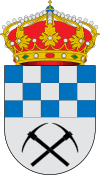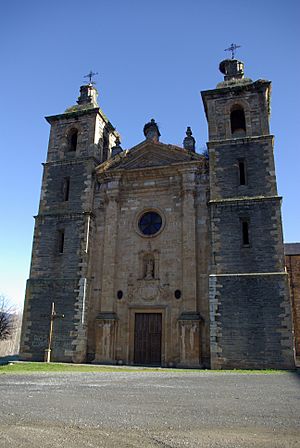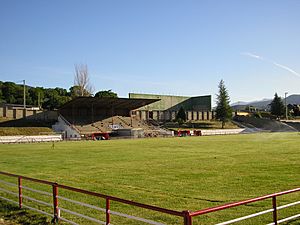Fabero facts for kids
Quick facts for kids
Fabero
|
||
|---|---|---|
|
||
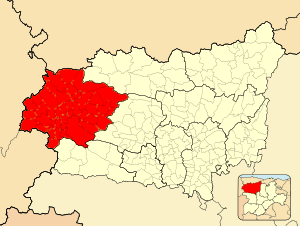
Image of Fabero
|
||
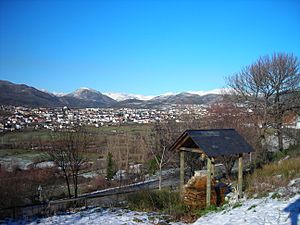 |
||
| Elevation | 676 m (2,218 ft) | |
| Population
(2018)
|
||
| • Total | 4,551 | |
| Area code(s) | +0034 987 | |
Fabero is a small town in northwest Spain. It's located in the Province of León, which is part of the Castilla y León region. About 5,000 people live there. It's also known as Fabeiro in the Galician language.
Fabero has a continental climate. This means summers are hot and dry, sometimes reaching 36°C during the day. Evenings are usually cool because of the mountains. Autumns are rainy, and winters are cold.
Contents
Exploring Fabero's Surroundings
Fabero is surrounded by beautiful mountains. These include the Sierra de Ancares and the Fornela Valley. Many small villages are scattered on the hillsides. The mountains are covered with oak, chestnut, and pine trees. Sometimes, you might even spot wolves or brown bears in the wilder parts.
The town is close to Villafranca, a historic city. Villafranca is a famous stop on the Pilgrims' Way to Compostela. Fabero is in the Bierzo area. This region is well-known for its excellent wines and vineyards.
Fabero's Economy: From Farms to Mines
For a long time, Fabero was a small farming community. People grew just enough food to feed themselves. This changed in the 1920s when coal mining began. Fabero had a lot of pure anthracite coal in the ground.
By the 1960s, the town grew a lot. Its population reached almost 10,000 people. Many workers came from southern Spain and Portugal to work in the mines. The mines were both underground and open-pit. Fabero even had the largest open-pit coal mine in Spain. The town has a famous statue of a barefoot miner.
Fabero was a busy mining town until the early 2000s. Then, most coal mines in Spain closed. This meant many people had to leave Fabero to find work elsewhere.
Delicious Food of Fabero
Fabero is in the Bierzo region of León. This area is great for farming. It's famous for its wines, chestnuts, and fresh produce. You can find delicious peppers, tomatoes, apples, pears, and cherries here.
Because it's a mountainous region, it has a long history of making cured meats. These include excellent Serrano hams and chorizo (a spicy sausage). A very popular local dish is 'botillo', which is also made with cured pork meat.
Fun Culture and Festivals
Fabero comes alive in the summer. Many festivals happen in the surrounding villages and towns, especially after mid-June.
The town organizes summer courses in painting and sculpture. These courses are held with the Fine Arts Department of the Complutense University of Madrid. Famous Spanish artists like Antonio Lopez and Julio Lopez have been special guests. They spoke and joined in the five-week-long courses.
Because of the area's mining history, there's an interesting Museum of the Mine. It's called Pozo Julia. This museum shows the history of the mines. You can see the equipment and tools used. You can also learn about how coal was taken out of the ground.
You can also find a monument that remembers a labor camp. This camp held prisoners after the Spanish Civil War. They were made to work in the coal mines.
Nearby, you can see an old Celtic settlement. There are also Neolithic cave paintings. A glacial lake called Pozo Cheiroso is close to town. The area also shows its Roman past. You can visit the remains of Roman gold mines in a place called Las Medulas.
The region has a long history, going back to the Middle Ages. The nearby Monastery of San Andres de Espinareda was started in the 12th century. The buildings you see today are from the 18th century.
Sports and Outdoor Fun
The hills and mountains around Fabero are great for outdoor activities. You can go rambling, biking, trekking, and horse-riding.
The town has outdoor and indoor swimming pools. There is also a football ground. The local football team plays in the first regional division. If you want more leisure centers, you can find them in nearby Ponferrada.
Trout fishing is also popular in the local rivers and mountain streams. After a day of activities, you can visit one of Fabero's many bars. They offer good wines, beers, and a great selection of 'tapas' (small snacks) at good prices.
Fabero's Twin Towns
Fabero is twinned with two towns in Portugal. This means they have a special friendship and cultural exchange.
| Country | Town | ||
|---|---|---|---|
| Portugal | 20px | Vila Pouca de Aguiar | |
| Portugal | 20px |
Images for kids
See also
 In Spanish: Fabero para niños
In Spanish: Fabero para niños


